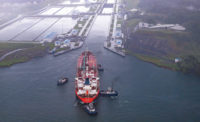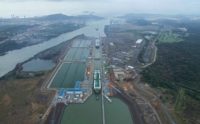Officials and researchers are closing in on the causes of hypersaline pollution of the main source of potable water in Miami-Dade County, Fla. Since 2014, complaints of elevated salinity in the Biscayne Aquifer have been voiced, with many pointing the finger at Florida Power and Light Co.’s (FPL) power plant in Florida City. In a case brought by several South Florida parties, an administrative law judge on Feb. 15 issued a ruling that confirmed the power plant as the source. A separate report from an investigation is out for public comment and could be final by May.
Cooling water for four units at Turkey Point, including two nuclear units, has seeped into the Biscayne Aquifer and spread in a lens of hypersaline groundwater that now extends four miles west of the power plant’s property, Judge Bram D.E. Canter wrote in his order. He also found that the Florida Dept. of Environmental Protection has failed to charge FPL with violations of law and required FPL to come into compliance with standards. To reflect his findings, he recommends the DEP amend or rescind a December 2014 Administrative Order in which DEP defined a salinity management plan for FPL.
Turkey Point’s unique cooling canal system (CCS) is most likely “the major contributing cause of the continuing westward movement of the saline water interface,” Canter wrote. The CCS is a 5,900-acre, unlined canal network that provides heat removal for Units 1, 3 and 4 and receives cooling-tower blowdown from Unit 5. Unit 1 is a 760-MW natural-gas/oil steam unit; Unit 5 is a 1113-MW combined-cycle natural-gas unit; and Units 3 and 4 are pressurized-water reactors, 700 MW each. Unit 2 has been converted to operate in synchronous condenser mode to provide voltage support for the transmission system in southeastern Florida.
The CCS functions as a radiator, lowering the water temperature by evaporation, convective heat transfer and radiated heat loss. After receiving heat from flow-through heat exchangers, cooling water is discharged to the CCS, where it is pumped through the 32 western canals, across the southern end of the CCS, and back up the seven eastern canals to the power-plant intake. From discharge to intake, the full 168-mile circuit through the CCS takes about 48 hours and reduces the water temperature 10°F to 15°F.
Because the canal system is unlined, it has “a direct connection to the groundwater,” Canter found. Process water, rainfall, stormwater runoff and groundwater infiltration replace water lost to evaporation and seepage. Because the salt in saltwater is left behind when the water evaporates and higher water temperature causes more evaporation, the water in the CCS tends to become saltier.
Higher salinity makes water denser, so the hypersaline water in the CCS sinks beneath the canals to the bottom of the Biscayne Aquifer, about 90 ft beneath the CCS. At that depth, a confining layer halts the downward movement of the hypersaline plume, which spreads out in all directions.
In 2013, FPL completed a 208-MW uprate of the plant’s two nuclear units, increasing their total capacity by 14%. Soon after, the canal system’s temperature and salinity spiked. About the same time, the South Florida Water Management District notified FPL that saline water from the system had moved westward from the L-31E canal, near the power plant’s property line.
To resolve complaints, FPL in October 2015 signed a consent agreement with Miami-Dade County’s Dept. of Regulatory and Economic Resources. “We require them to intercept, capture, contain and retract the hypersaline groundwater plume to their property boundary,” says Wilbur Mayorga, chief of the department’s Environmental Monitoring and Restoration Division. In a statement, a spokeswoman told ENR, “FPL continues to take action and improve canal conditions at Turkey Point. FPL’s actions have been successful by reducing salinity levels in the Cooling Canal System, significantly improving water quality and stabilizing operations at the site.”
FPL is pumping in fresh water from the L-31E canal, but that is only a stopgap. In June 2015, Miami-Dade County commissioned a study and report on the growing problem by David A. Chin, professor of civil and environmental engineering at the University of Miami. Chin found the heat-rejection rate following the uprate was “significantly greater” than before the uprate. “Measured temperature data during the period of record indicate that the thermal efficiency of the CCS has decreased between the pre-uprate and post-uprate periods,” he said.
The causes of increased salinity are still open to “reasonable disagreement,” Cantor ruled. But Chin’s report says, “There is little doubt that seepage from the CCS into the Biscayne Aquifer has caused salinity increases within the aquifer, and this impact extends several miles inland from the CCS.”
Chin’s report was issued for public comment on Feb. 19. Comments will be addressed before the final report is published in late May.



